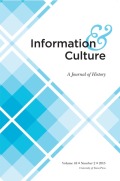Finn, M. “Information Infrastructure and Descriptions of the 1857 Fort Tejon Earthquake,” Information & Culture, volume 48, number 2 (2013): 194-221.
 A magnitude 7.9 earthquake occured in the San Andreas Fault near Fort Tejon in the morning of January 9, 1857. Shaking was reported from Marysville, CA in the north to San Diego in the south, and two people died. After the quake, Californians worked together to understand the cause of the earthquake and the extent of the damage. The author Megan Finn (a postdoctoral researcher at Microsoft at the time of publication) focuses on California’s information infrastructure at the time, and, using newspaper articles, letters, and other contemporaneous primary sources, examines how Californians at the time understood earthquakes. In addition to examining 19th-century media (newspapers, letters, and telegrams), Finn describes the role played by the media infrastructure—including steamboats, fast curriers, the postal system, and the telegraph system—as well as the influence of customs of record keeping of the time (particularly timekeeping), which were different from those prevalent today.
A magnitude 7.9 earthquake occured in the San Andreas Fault near Fort Tejon in the morning of January 9, 1857. Shaking was reported from Marysville, CA in the north to San Diego in the south, and two people died. After the quake, Californians worked together to understand the cause of the earthquake and the extent of the damage. The author Megan Finn (a postdoctoral researcher at Microsoft at the time of publication) focuses on California’s information infrastructure at the time, and, using newspaper articles, letters, and other contemporaneous primary sources, examines how Californians at the time understood earthquakes. In addition to examining 19th-century media (newspapers, letters, and telegrams), Finn describes the role played by the media infrastructure—including steamboats, fast curriers, the postal system, and the telegraph system—as well as the influence of customs of record keeping of the time (particularly timekeeping), which were different from those prevalent today.
From a contemporary standpoint, the contemporary records of the 1857 earthquake are “lacking.” In focusing on the 19th-century information infrastructure, however, this article indicates how our modern understanding of earthquakes might be influenced by our current information infrastructure. This article should be useful for graduate students and researchers.
Original Author: Yasutoshi Abe, University of Southern California [日本語でのアノテーション]
Translator: Kristina Buhrman, Florida State University
![[Teach311 + COVID-19] Collective](https://blogs.ntu.edu.sg/teach311/files/2020/04/Banner.jpg)